Human Resource Management Report: Tesco, HRM vs. Personnel Management
VerifiedAdded on 2020/01/23
|14
|3967
|125
Report
AI Summary
This report provides a comprehensive analysis of Human Resource Management (HRM) practices within Tesco, a major UK retailer. It begins by differentiating between HRM and personnel management, highlighting the evolution towards a more strategic and employee-focused approach. The report then delves into key HRM functions at Tesco, including recruitment, selection, training and development, and the crucial role of line managers in achieving organizational goals. It further examines the importance of employment legislation and its impact on various aspects of the employment relationship. The report analyzes the process of human resource planning, outlining its significance in strategic alignment, employee satisfaction, and future manpower needs. It then compares Tesco's recruitment and selection processes with those of the British Hospitality Association (BHA), exploring the use of internal and external recruitment sources. The report emphasizes the link between motivation theories and reward systems, discussing various methods used to encourage employee performance. Finally, it addresses the impact of legal and regulatory frameworks on employment cessation arrangements within the organization, providing insights into the practical application of HRM principles in a real-world business context.
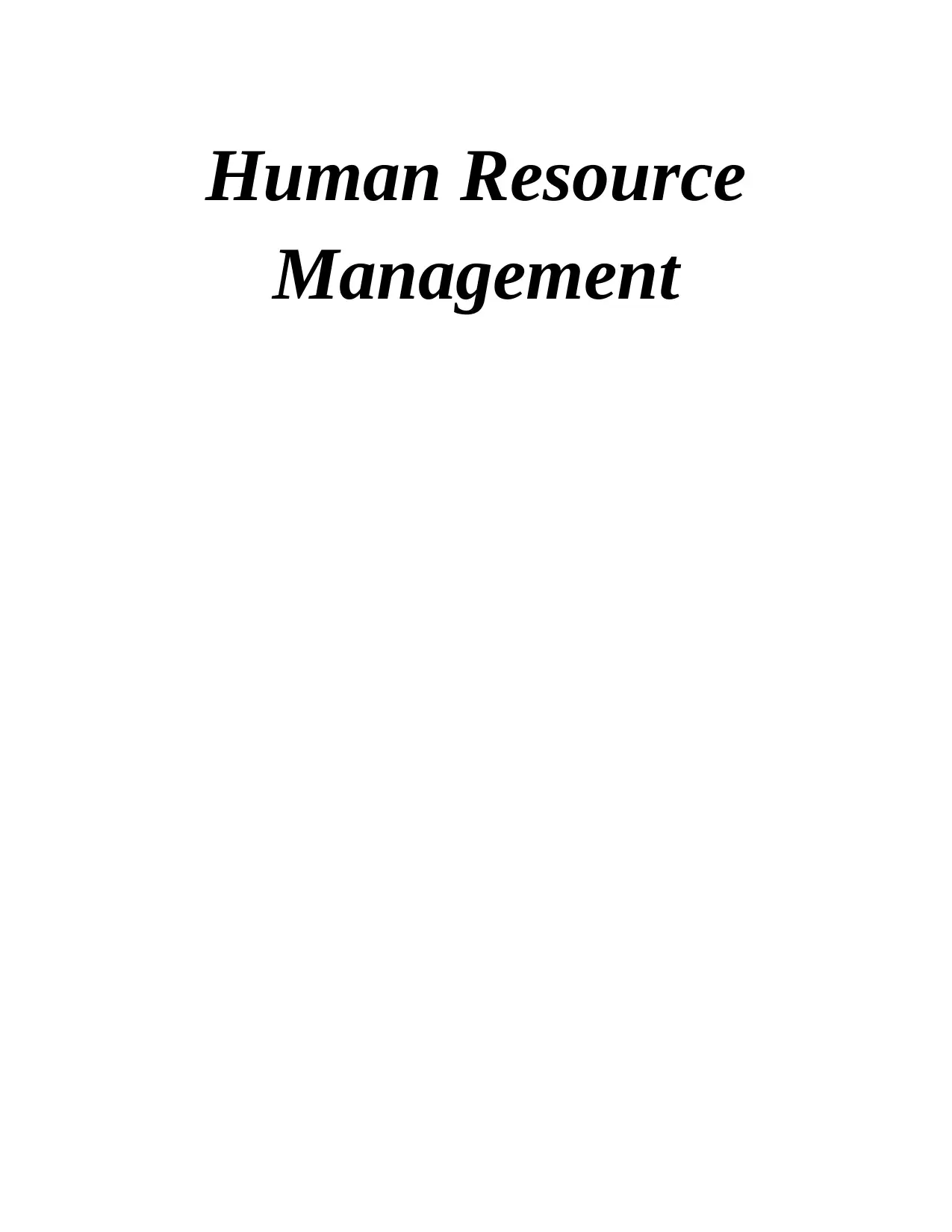
Human Resource
Management
Management
Paraphrase This Document
Need a fresh take? Get an instant paraphrase of this document with our AI Paraphraser
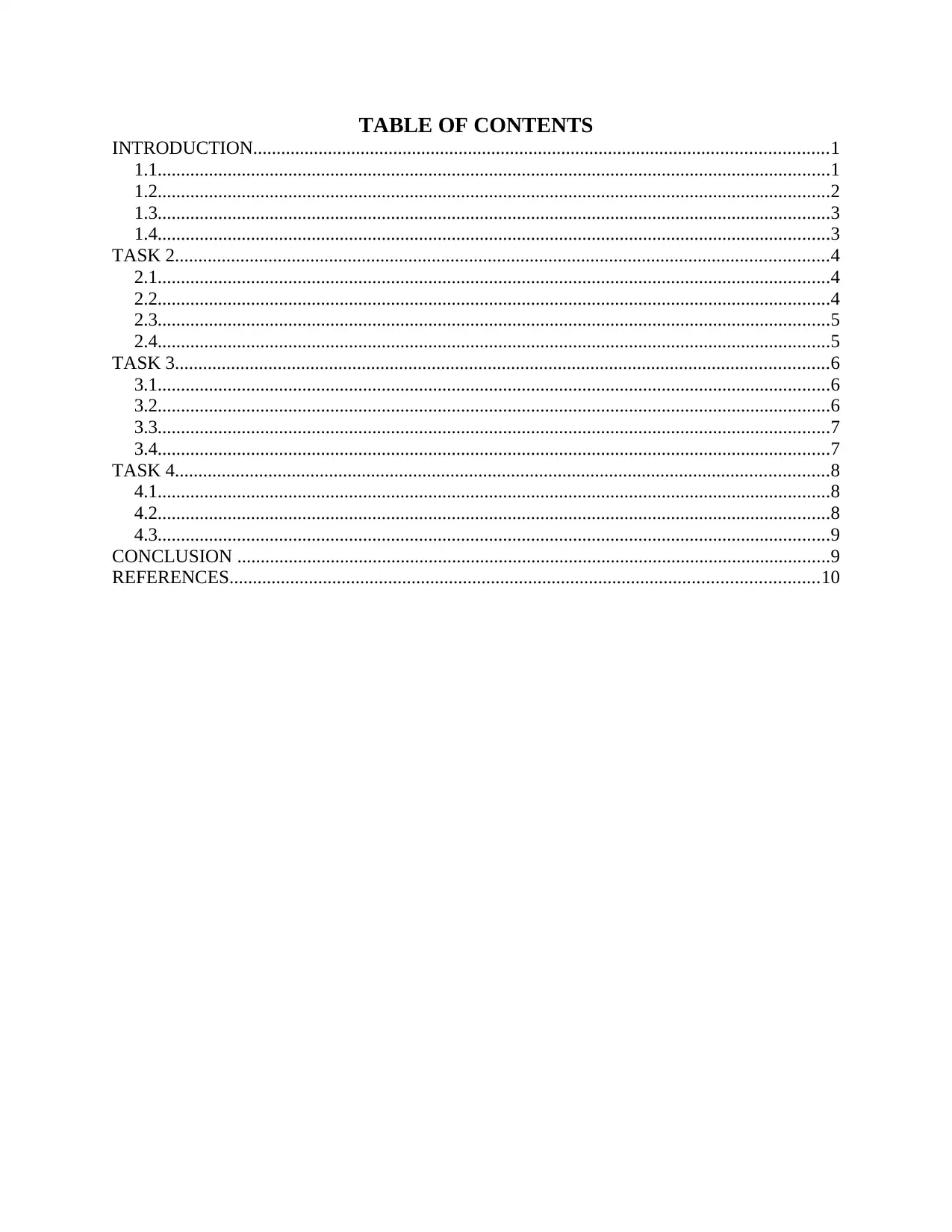
TABLE OF CONTENTS
INTRODUCTION...........................................................................................................................1
1.1................................................................................................................................................1
1.2................................................................................................................................................2
1.3................................................................................................................................................3
1.4................................................................................................................................................3
TASK 2............................................................................................................................................4
2.1................................................................................................................................................4
2.2................................................................................................................................................4
2.3................................................................................................................................................5
2.4................................................................................................................................................5
TASK 3............................................................................................................................................6
3.1................................................................................................................................................6
3.2................................................................................................................................................6
3.3................................................................................................................................................7
3.4................................................................................................................................................7
TASK 4............................................................................................................................................8
4.1................................................................................................................................................8
4.2................................................................................................................................................8
4.3................................................................................................................................................9
CONCLUSION ...............................................................................................................................9
REFERENCES..............................................................................................................................10
INTRODUCTION...........................................................................................................................1
1.1................................................................................................................................................1
1.2................................................................................................................................................2
1.3................................................................................................................................................3
1.4................................................................................................................................................3
TASK 2............................................................................................................................................4
2.1................................................................................................................................................4
2.2................................................................................................................................................4
2.3................................................................................................................................................5
2.4................................................................................................................................................5
TASK 3............................................................................................................................................6
3.1................................................................................................................................................6
3.2................................................................................................................................................6
3.3................................................................................................................................................7
3.4................................................................................................................................................7
TASK 4............................................................................................................................................8
4.1................................................................................................................................................8
4.2................................................................................................................................................8
4.3................................................................................................................................................9
CONCLUSION ...............................................................................................................................9
REFERENCES..............................................................................................................................10
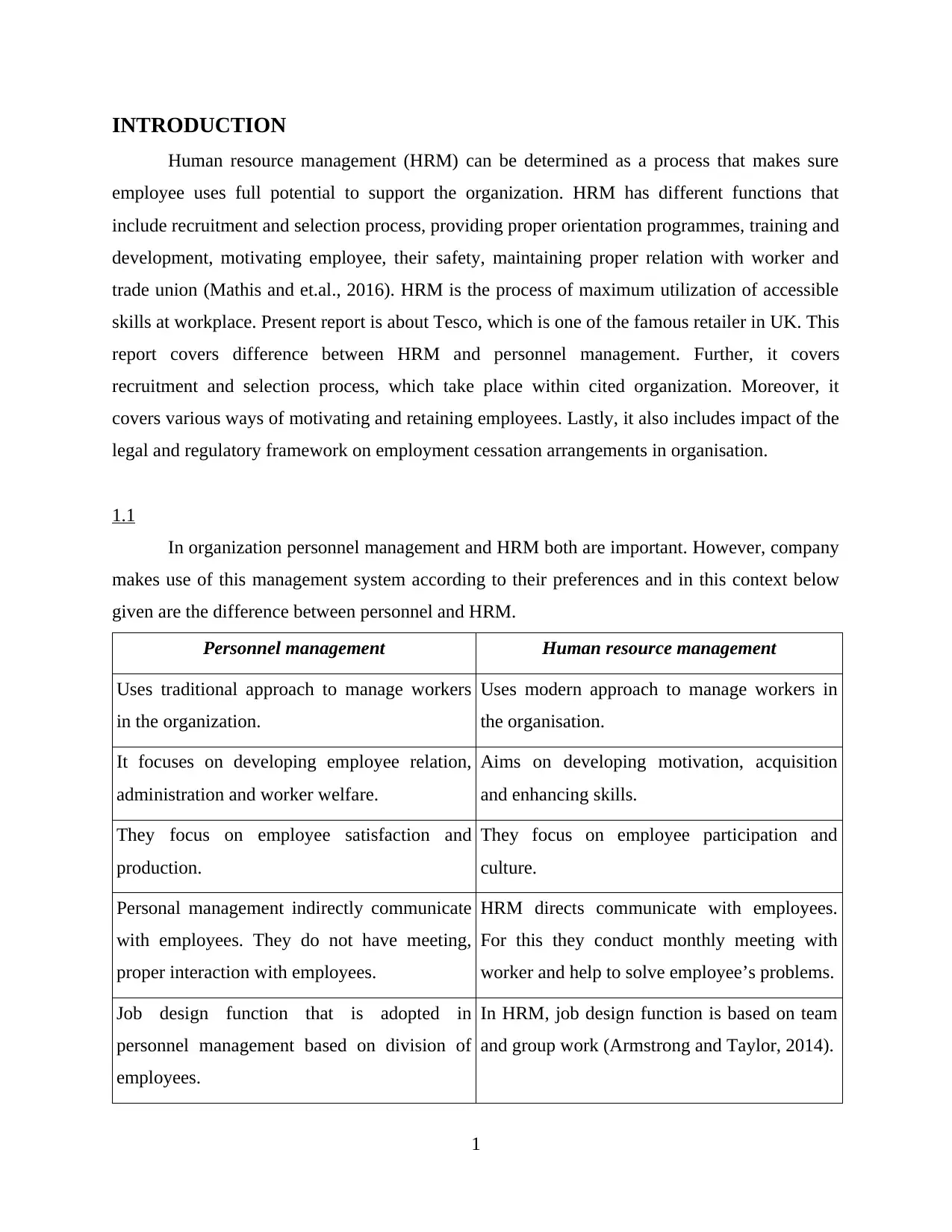
INTRODUCTION
Human resource management (HRM) can be determined as a process that makes sure
employee uses full potential to support the organization. HRM has different functions that
include recruitment and selection process, providing proper orientation programmes, training and
development, motivating employee, their safety, maintaining proper relation with worker and
trade union (Mathis and et.al., 2016). HRM is the process of maximum utilization of accessible
skills at workplace. Present report is about Tesco, which is one of the famous retailer in UK. This
report covers difference between HRM and personnel management. Further, it covers
recruitment and selection process, which take place within cited organization. Moreover, it
covers various ways of motivating and retaining employees. Lastly, it also includes impact of the
legal and regulatory framework on employment cessation arrangements in organisation.
1.1
In organization personnel management and HRM both are important. However, company
makes use of this management system according to their preferences and in this context below
given are the difference between personnel and HRM.
Personnel management Human resource management
Uses traditional approach to manage workers
in the organization.
Uses modern approach to manage workers in
the organisation.
It focuses on developing employee relation,
administration and worker welfare.
Aims on developing motivation, acquisition
and enhancing skills.
They focus on employee satisfaction and
production.
They focus on employee participation and
culture.
Personal management indirectly communicate
with employees. They do not have meeting,
proper interaction with employees.
HRM directs communicate with employees.
For this they conduct monthly meeting with
worker and help to solve employee’s problems.
Job design function that is adopted in
personnel management based on division of
employees.
In HRM, job design function is based on team
and group work (Armstrong and Taylor, 2014).
1
Human resource management (HRM) can be determined as a process that makes sure
employee uses full potential to support the organization. HRM has different functions that
include recruitment and selection process, providing proper orientation programmes, training and
development, motivating employee, their safety, maintaining proper relation with worker and
trade union (Mathis and et.al., 2016). HRM is the process of maximum utilization of accessible
skills at workplace. Present report is about Tesco, which is one of the famous retailer in UK. This
report covers difference between HRM and personnel management. Further, it covers
recruitment and selection process, which take place within cited organization. Moreover, it
covers various ways of motivating and retaining employees. Lastly, it also includes impact of the
legal and regulatory framework on employment cessation arrangements in organisation.
1.1
In organization personnel management and HRM both are important. However, company
makes use of this management system according to their preferences and in this context below
given are the difference between personnel and HRM.
Personnel management Human resource management
Uses traditional approach to manage workers
in the organization.
Uses modern approach to manage workers in
the organisation.
It focuses on developing employee relation,
administration and worker welfare.
Aims on developing motivation, acquisition
and enhancing skills.
They focus on employee satisfaction and
production.
They focus on employee participation and
culture.
Personal management indirectly communicate
with employees. They do not have meeting,
proper interaction with employees.
HRM directs communicate with employees.
For this they conduct monthly meeting with
worker and help to solve employee’s problems.
Job design function that is adopted in
personnel management based on division of
employees.
In HRM, job design function is based on team
and group work (Armstrong and Taylor, 2014).
1
⊘ This is a preview!⊘
Do you want full access?
Subscribe today to unlock all pages.

Trusted by 1+ million students worldwide
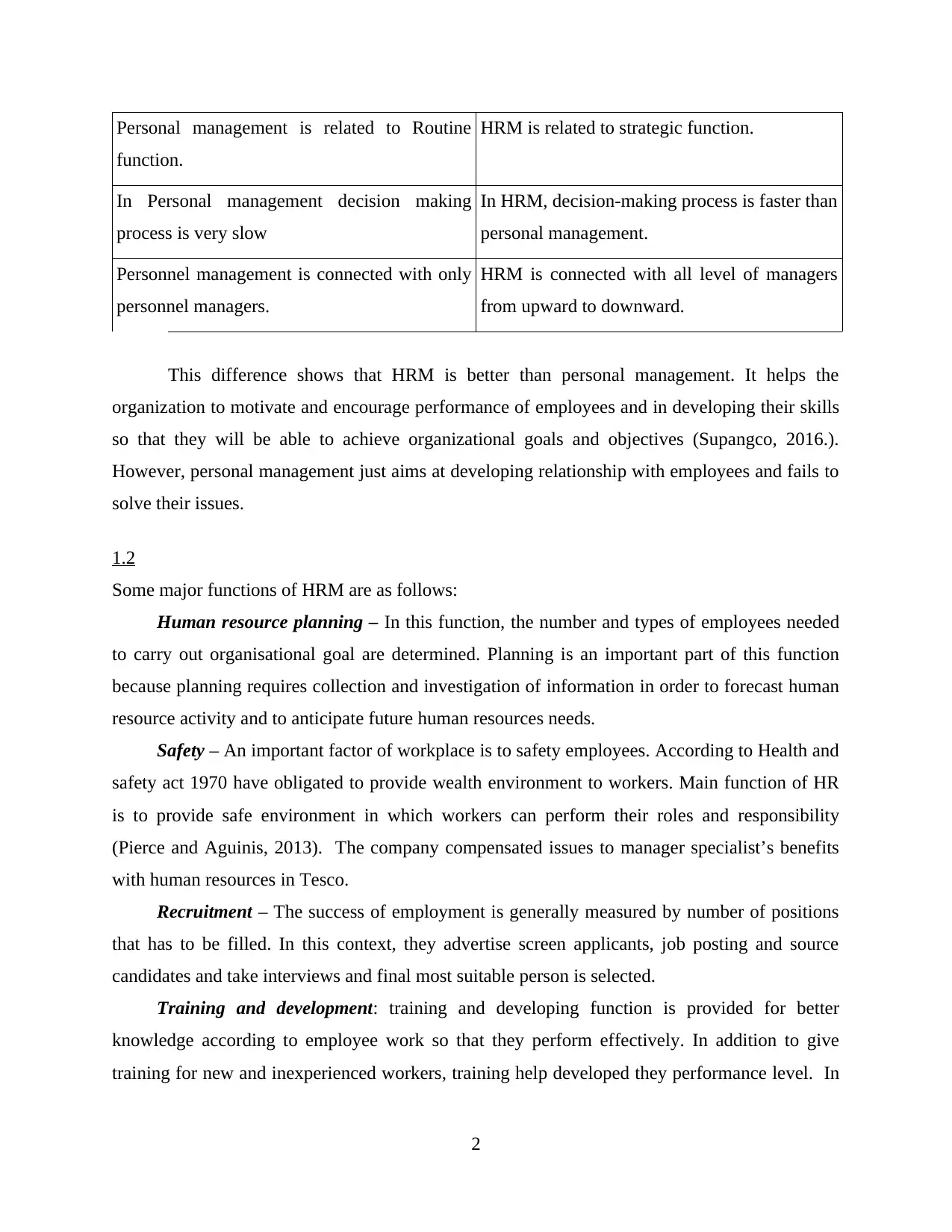
Personal management is related to Routine
function.
HRM is related to strategic function.
In Personal management decision making
process is very slow
In HRM, decision-making process is faster than
personal management.
Personnel management is connected with only
personnel managers.
HRM is connected with all level of managers
from upward to downward.
This difference shows that HRM is better than personal management. It helps the
organization to motivate and encourage performance of employees and in developing their skills
so that they will be able to achieve organizational goals and objectives (Supangco, 2016.).
However, personal management just aims at developing relationship with employees and fails to
solve their issues.
1.2
Some major functions of HRM are as follows:
Human resource planning – In this function, the number and types of employees needed
to carry out organisational goal are determined. Planning is an important part of this function
because planning requires collection and investigation of information in order to forecast human
resource activity and to anticipate future human resources needs.
Safety – An important factor of workplace is to safety employees. According to Health and
safety act 1970 have obligated to provide wealth environment to workers. Main function of HR
is to provide safe environment in which workers can perform their roles and responsibility
(Pierce and Aguinis, 2013). The company compensated issues to manager specialist’s benefits
with human resources in Tesco.
Recruitment – The success of employment is generally measured by number of positions
that has to be filled. In this context, they advertise screen applicants, job posting and source
candidates and take interviews and final most suitable person is selected.
Training and development: training and developing function is provided for better
knowledge according to employee work so that they perform effectively. In addition to give
training for new and inexperienced workers, training help developed they performance level. In
2
function.
HRM is related to strategic function.
In Personal management decision making
process is very slow
In HRM, decision-making process is faster than
personal management.
Personnel management is connected with only
personnel managers.
HRM is connected with all level of managers
from upward to downward.
This difference shows that HRM is better than personal management. It helps the
organization to motivate and encourage performance of employees and in developing their skills
so that they will be able to achieve organizational goals and objectives (Supangco, 2016.).
However, personal management just aims at developing relationship with employees and fails to
solve their issues.
1.2
Some major functions of HRM are as follows:
Human resource planning – In this function, the number and types of employees needed
to carry out organisational goal are determined. Planning is an important part of this function
because planning requires collection and investigation of information in order to forecast human
resource activity and to anticipate future human resources needs.
Safety – An important factor of workplace is to safety employees. According to Health and
safety act 1970 have obligated to provide wealth environment to workers. Main function of HR
is to provide safe environment in which workers can perform their roles and responsibility
(Pierce and Aguinis, 2013). The company compensated issues to manager specialist’s benefits
with human resources in Tesco.
Recruitment – The success of employment is generally measured by number of positions
that has to be filled. In this context, they advertise screen applicants, job posting and source
candidates and take interviews and final most suitable person is selected.
Training and development: training and developing function is provided for better
knowledge according to employee work so that they perform effectively. In addition to give
training for new and inexperienced workers, training help developed they performance level. In
2
Paraphrase This Document
Need a fresh take? Get an instant paraphrase of this document with our AI Paraphraser
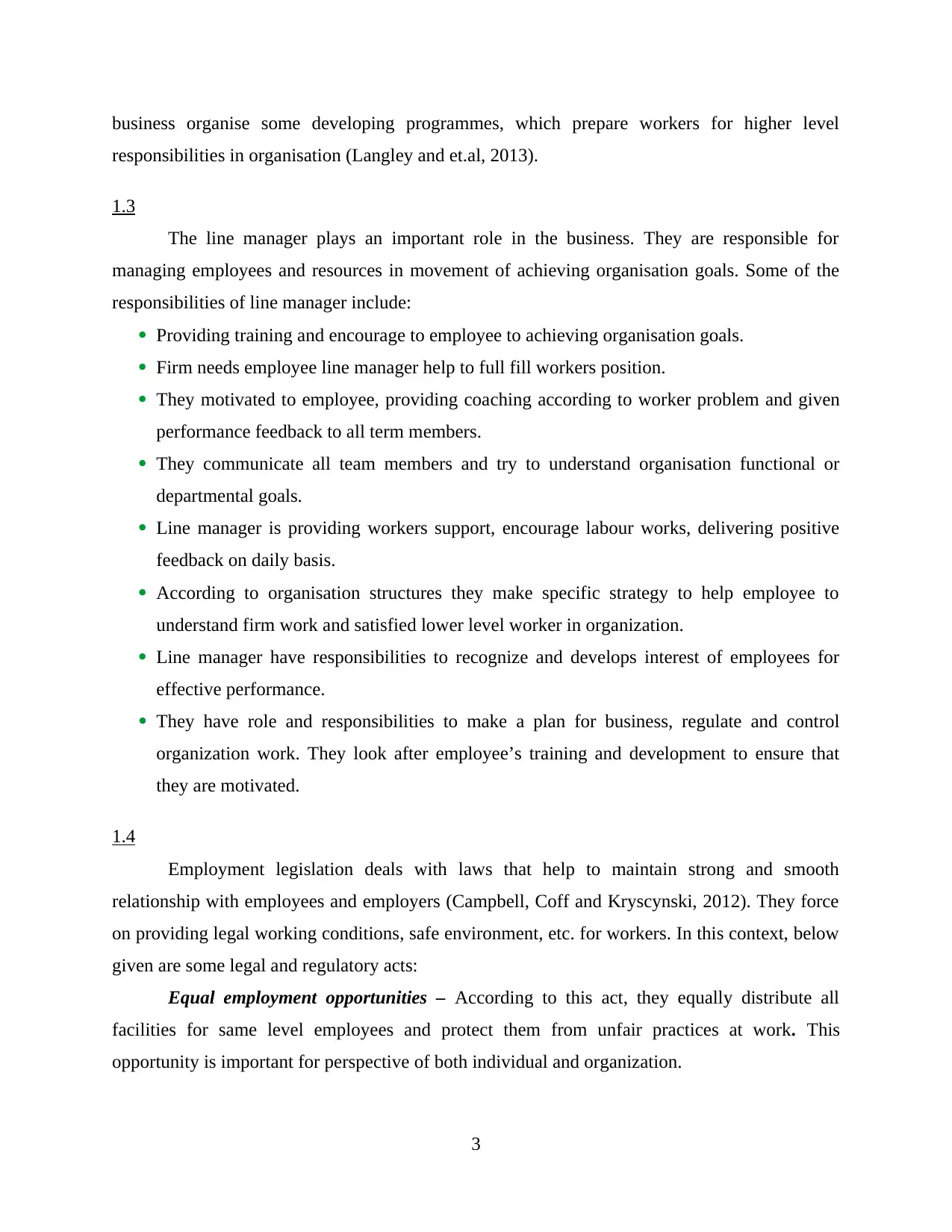
business organise some developing programmes, which prepare workers for higher level
responsibilities in organisation (Langley and et.al, 2013).
1.3
The line manager plays an important role in the business. They are responsible for
managing employees and resources in movement of achieving organisation goals. Some of the
responsibilities of line manager include:
Providing training and encourage to employee to achieving organisation goals.
Firm needs employee line manager help to full fill workers position.
They motivated to employee, providing coaching according to worker problem and given
performance feedback to all term members.
They communicate all team members and try to understand organisation functional or
departmental goals.
Line manager is providing workers support, encourage labour works, delivering positive
feedback on daily basis.
According to organisation structures they make specific strategy to help employee to
understand firm work and satisfied lower level worker in organization.
Line manager have responsibilities to recognize and develops interest of employees for
effective performance.
They have role and responsibilities to make a plan for business, regulate and control
organization work. They look after employee’s training and development to ensure that
they are motivated.
1.4
Employment legislation deals with laws that help to maintain strong and smooth
relationship with employees and employers (Campbell, Coff and Kryscynski, 2012). They force
on providing legal working conditions, safe environment, etc. for workers. In this context, below
given are some legal and regulatory acts:
Equal employment opportunities – According to this act, they equally distribute all
facilities for same level employees and protect them from unfair practices at work. This
opportunity is important for perspective of both individual and organization.
3
responsibilities in organisation (Langley and et.al, 2013).
1.3
The line manager plays an important role in the business. They are responsible for
managing employees and resources in movement of achieving organisation goals. Some of the
responsibilities of line manager include:
Providing training and encourage to employee to achieving organisation goals.
Firm needs employee line manager help to full fill workers position.
They motivated to employee, providing coaching according to worker problem and given
performance feedback to all term members.
They communicate all team members and try to understand organisation functional or
departmental goals.
Line manager is providing workers support, encourage labour works, delivering positive
feedback on daily basis.
According to organisation structures they make specific strategy to help employee to
understand firm work and satisfied lower level worker in organization.
Line manager have responsibilities to recognize and develops interest of employees for
effective performance.
They have role and responsibilities to make a plan for business, regulate and control
organization work. They look after employee’s training and development to ensure that
they are motivated.
1.4
Employment legislation deals with laws that help to maintain strong and smooth
relationship with employees and employers (Campbell, Coff and Kryscynski, 2012). They force
on providing legal working conditions, safe environment, etc. for workers. In this context, below
given are some legal and regulatory acts:
Equal employment opportunities – According to this act, they equally distribute all
facilities for same level employees and protect them from unfair practices at work. This
opportunity is important for perspective of both individual and organization.
3
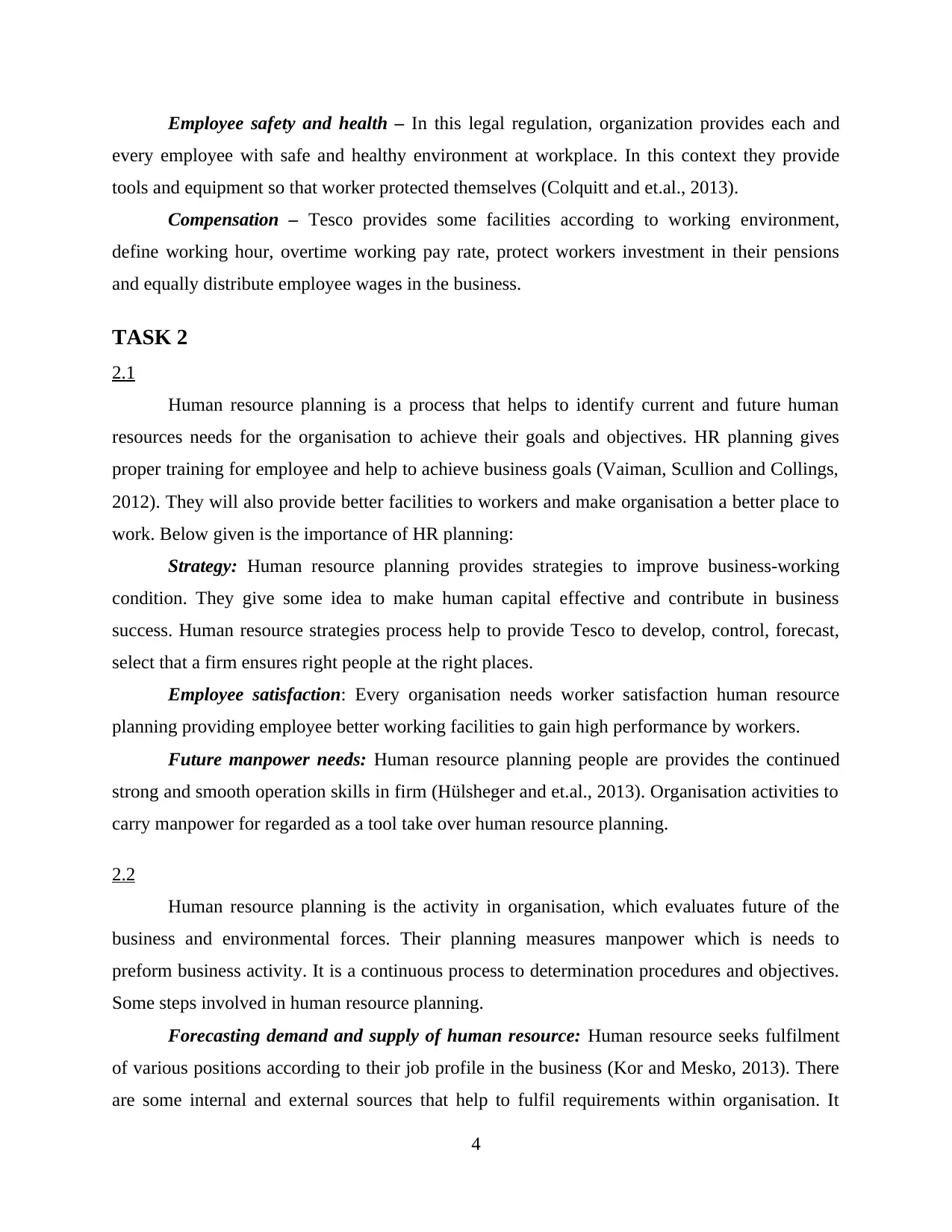
Employee safety and health – In this legal regulation, organization provides each and
every employee with safe and healthy environment at workplace. In this context they provide
tools and equipment so that worker protected themselves (Colquitt and et.al., 2013).
Compensation – Tesco provides some facilities according to working environment,
define working hour, overtime working pay rate, protect workers investment in their pensions
and equally distribute employee wages in the business.
TASK 2
2.1
Human resource planning is a process that helps to identify current and future human
resources needs for the organisation to achieve their goals and objectives. HR planning gives
proper training for employee and help to achieve business goals (Vaiman, Scullion and Collings,
2012). They will also provide better facilities to workers and make organisation a better place to
work. Below given is the importance of HR planning:
Strategy: Human resource planning provides strategies to improve business-working
condition. They give some idea to make human capital effective and contribute in business
success. Human resource strategies process help to provide Tesco to develop, control, forecast,
select that a firm ensures right people at the right places.
Employee satisfaction: Every organisation needs worker satisfaction human resource
planning providing employee better working facilities to gain high performance by workers.
Future manpower needs: Human resource planning people are provides the continued
strong and smooth operation skills in firm (Hülsheger and et.al., 2013). Organisation activities to
carry manpower for regarded as a tool take over human resource planning.
2.2
Human resource planning is the activity in organisation, which evaluates future of the
business and environmental forces. Their planning measures manpower which is needs to
preform business activity. It is a continuous process to determination procedures and objectives.
Some steps involved in human resource planning.
Forecasting demand and supply of human resource: Human resource seeks fulfilment
of various positions according to their job profile in the business (Kor and Mesko, 2013). There
are some internal and external sources that help to fulfil requirements within organisation. It
4
every employee with safe and healthy environment at workplace. In this context they provide
tools and equipment so that worker protected themselves (Colquitt and et.al., 2013).
Compensation – Tesco provides some facilities according to working environment,
define working hour, overtime working pay rate, protect workers investment in their pensions
and equally distribute employee wages in the business.
TASK 2
2.1
Human resource planning is a process that helps to identify current and future human
resources needs for the organisation to achieve their goals and objectives. HR planning gives
proper training for employee and help to achieve business goals (Vaiman, Scullion and Collings,
2012). They will also provide better facilities to workers and make organisation a better place to
work. Below given is the importance of HR planning:
Strategy: Human resource planning provides strategies to improve business-working
condition. They give some idea to make human capital effective and contribute in business
success. Human resource strategies process help to provide Tesco to develop, control, forecast,
select that a firm ensures right people at the right places.
Employee satisfaction: Every organisation needs worker satisfaction human resource
planning providing employee better working facilities to gain high performance by workers.
Future manpower needs: Human resource planning people are provides the continued
strong and smooth operation skills in firm (Hülsheger and et.al., 2013). Organisation activities to
carry manpower for regarded as a tool take over human resource planning.
2.2
Human resource planning is the activity in organisation, which evaluates future of the
business and environmental forces. Their planning measures manpower which is needs to
preform business activity. It is a continuous process to determination procedures and objectives.
Some steps involved in human resource planning.
Forecasting demand and supply of human resource: Human resource seeks fulfilment
of various positions according to their job profile in the business (Kor and Mesko, 2013). There
are some internal and external sources that help to fulfil requirements within organisation. It
4
⊘ This is a preview!⊘
Do you want full access?
Subscribe today to unlock all pages.

Trusted by 1+ million students worldwide
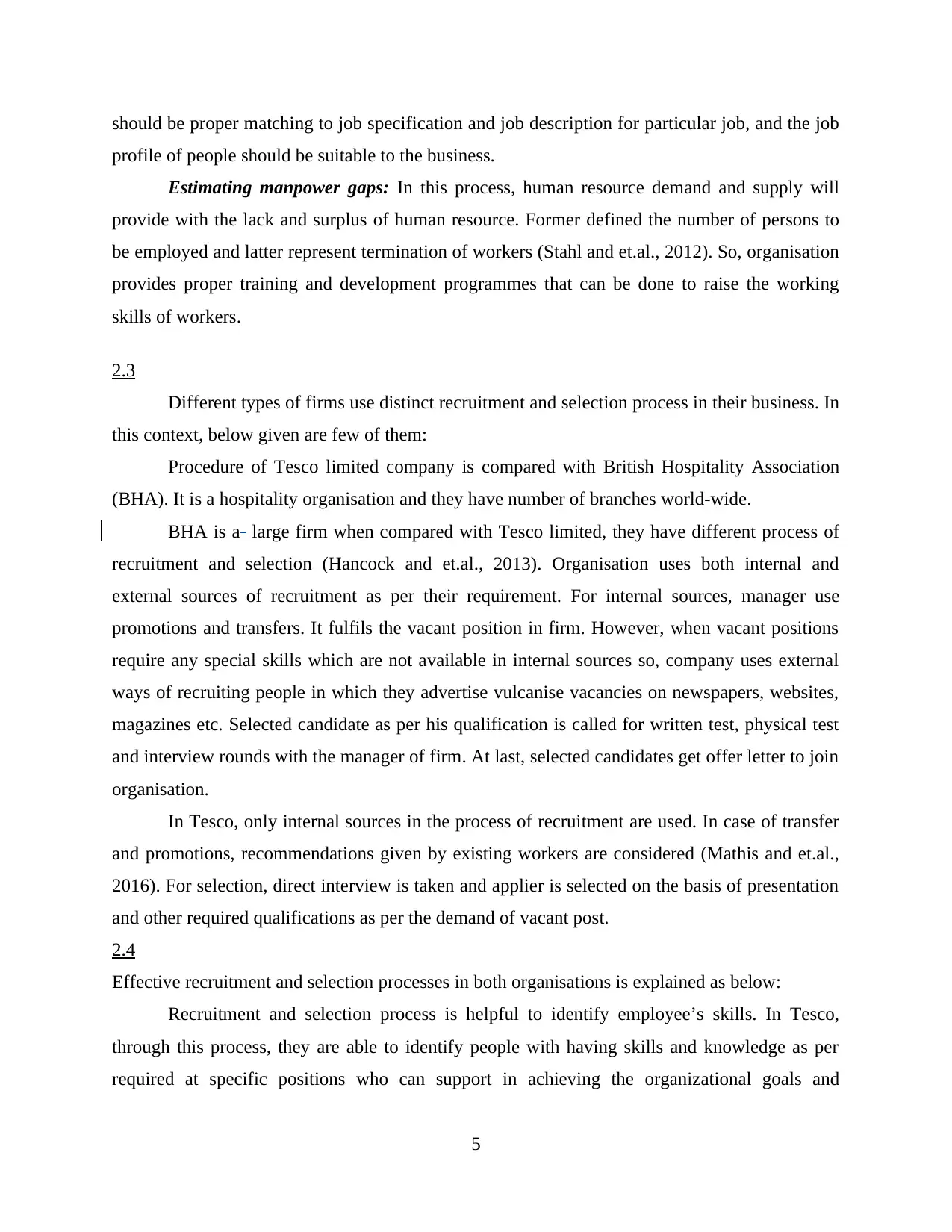
should be proper matching to job specification and job description for particular job, and the job
profile of people should be suitable to the business.
Estimating manpower gaps: In this process, human resource demand and supply will
provide with the lack and surplus of human resource. Former defined the number of persons to
be employed and latter represent termination of workers (Stahl and et.al., 2012). So, organisation
provides proper training and development programmes that can be done to raise the working
skills of workers.
2.3
Different types of firms use distinct recruitment and selection process in their business. In
this context, below given are few of them:
Procedure of Tesco limited company is compared with British Hospitality Association
(BHA). It is a hospitality organisation and they have number of branches world-wide.
BHA is a large firm when compared with Tesco limited, they have different process of
recruitment and selection (Hancock and et.al., 2013). Organisation uses both internal and
external sources of recruitment as per their requirement. For internal sources, manager use
promotions and transfers. It fulfils the vacant position in firm. However, when vacant positions
require any special skills which are not available in internal sources so, company uses external
ways of recruiting people in which they advertise vulcanise vacancies on newspapers, websites,
magazines etc. Selected candidate as per his qualification is called for written test, physical test
and interview rounds with the manager of firm. At last, selected candidates get offer letter to join
organisation.
In Tesco, only internal sources in the process of recruitment are used. In case of transfer
and promotions, recommendations given by existing workers are considered (Mathis and et.al.,
2016). For selection, direct interview is taken and applier is selected on the basis of presentation
and other required qualifications as per the demand of vacant post.
2.4
Effective recruitment and selection processes in both organisations is explained as below:
Recruitment and selection process is helpful to identify employee’s skills. In Tesco,
through this process, they are able to identify people with having skills and knowledge as per
required at specific positions who can support in achieving the organizational goals and
5
profile of people should be suitable to the business.
Estimating manpower gaps: In this process, human resource demand and supply will
provide with the lack and surplus of human resource. Former defined the number of persons to
be employed and latter represent termination of workers (Stahl and et.al., 2012). So, organisation
provides proper training and development programmes that can be done to raise the working
skills of workers.
2.3
Different types of firms use distinct recruitment and selection process in their business. In
this context, below given are few of them:
Procedure of Tesco limited company is compared with British Hospitality Association
(BHA). It is a hospitality organisation and they have number of branches world-wide.
BHA is a large firm when compared with Tesco limited, they have different process of
recruitment and selection (Hancock and et.al., 2013). Organisation uses both internal and
external sources of recruitment as per their requirement. For internal sources, manager use
promotions and transfers. It fulfils the vacant position in firm. However, when vacant positions
require any special skills which are not available in internal sources so, company uses external
ways of recruiting people in which they advertise vulcanise vacancies on newspapers, websites,
magazines etc. Selected candidate as per his qualification is called for written test, physical test
and interview rounds with the manager of firm. At last, selected candidates get offer letter to join
organisation.
In Tesco, only internal sources in the process of recruitment are used. In case of transfer
and promotions, recommendations given by existing workers are considered (Mathis and et.al.,
2016). For selection, direct interview is taken and applier is selected on the basis of presentation
and other required qualifications as per the demand of vacant post.
2.4
Effective recruitment and selection processes in both organisations is explained as below:
Recruitment and selection process is helpful to identify employee’s skills. In Tesco,
through this process, they are able to identify people with having skills and knowledge as per
required at specific positions who can support in achieving the organizational goals and
5
Paraphrase This Document
Need a fresh take? Get an instant paraphrase of this document with our AI Paraphraser
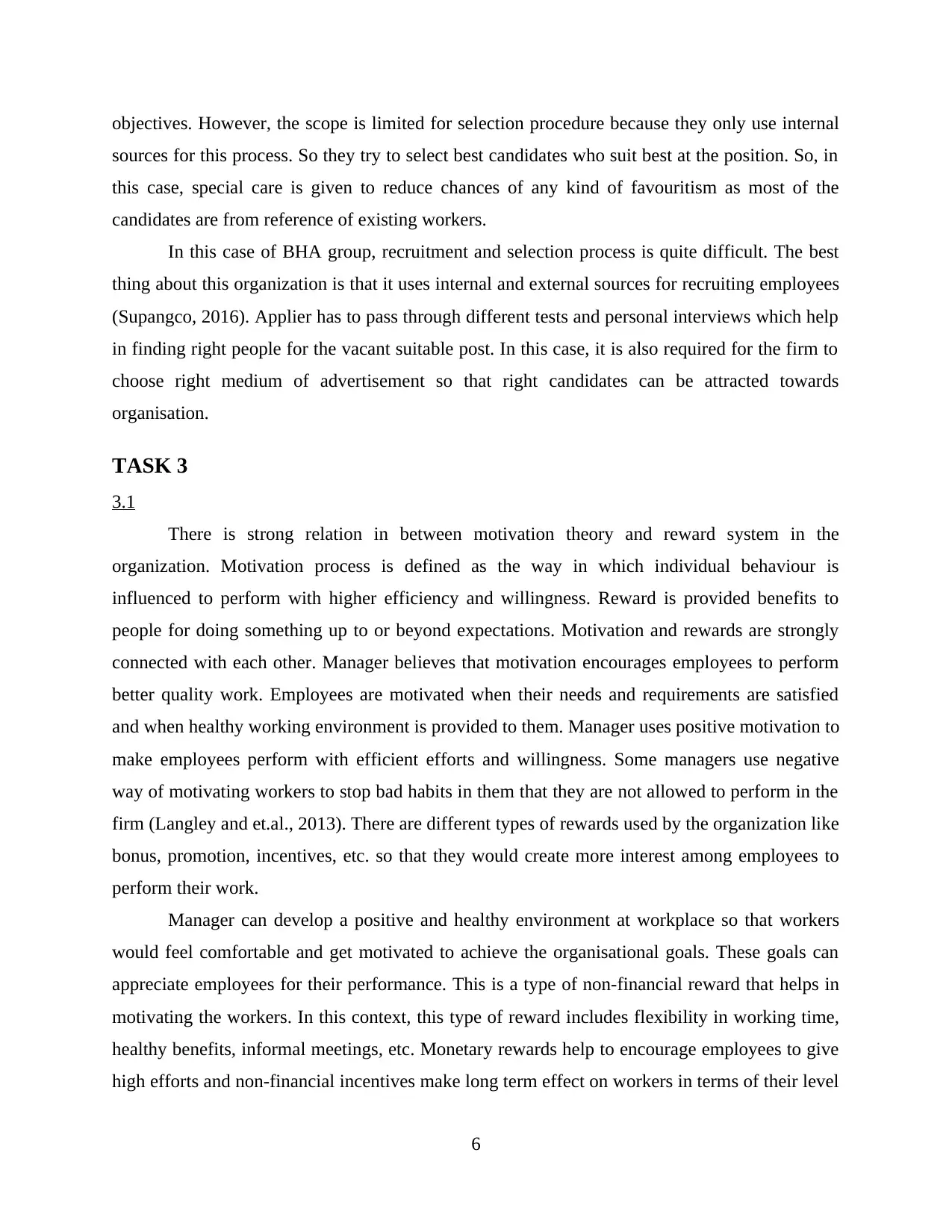
objectives. However, the scope is limited for selection procedure because they only use internal
sources for this process. So they try to select best candidates who suit best at the position. So, in
this case, special care is given to reduce chances of any kind of favouritism as most of the
candidates are from reference of existing workers.
In this case of BHA group, recruitment and selection process is quite difficult. The best
thing about this organization is that it uses internal and external sources for recruiting employees
(Supangco, 2016). Applier has to pass through different tests and personal interviews which help
in finding right people for the vacant suitable post. In this case, it is also required for the firm to
choose right medium of advertisement so that right candidates can be attracted towards
organisation.
TASK 3
3.1
There is strong relation in between motivation theory and reward system in the
organization. Motivation process is defined as the way in which individual behaviour is
influenced to perform with higher efficiency and willingness. Reward is provided benefits to
people for doing something up to or beyond expectations. Motivation and rewards are strongly
connected with each other. Manager believes that motivation encourages employees to perform
better quality work. Employees are motivated when their needs and requirements are satisfied
and when healthy working environment is provided to them. Manager uses positive motivation to
make employees perform with efficient efforts and willingness. Some managers use negative
way of motivating workers to stop bad habits in them that they are not allowed to perform in the
firm (Langley and et.al., 2013). There are different types of rewards used by the organization like
bonus, promotion, incentives, etc. so that they would create more interest among employees to
perform their work.
Manager can develop a positive and healthy environment at workplace so that workers
would feel comfortable and get motivated to achieve the organisational goals. These goals can
appreciate employees for their performance. This is a type of non-financial reward that helps in
motivating the workers. In this context, this type of reward includes flexibility in working time,
healthy benefits, informal meetings, etc. Monetary rewards help to encourage employees to give
high efforts and non-financial incentives make long term effect on workers in terms of their level
6
sources for this process. So they try to select best candidates who suit best at the position. So, in
this case, special care is given to reduce chances of any kind of favouritism as most of the
candidates are from reference of existing workers.
In this case of BHA group, recruitment and selection process is quite difficult. The best
thing about this organization is that it uses internal and external sources for recruiting employees
(Supangco, 2016). Applier has to pass through different tests and personal interviews which help
in finding right people for the vacant suitable post. In this case, it is also required for the firm to
choose right medium of advertisement so that right candidates can be attracted towards
organisation.
TASK 3
3.1
There is strong relation in between motivation theory and reward system in the
organization. Motivation process is defined as the way in which individual behaviour is
influenced to perform with higher efficiency and willingness. Reward is provided benefits to
people for doing something up to or beyond expectations. Motivation and rewards are strongly
connected with each other. Manager believes that motivation encourages employees to perform
better quality work. Employees are motivated when their needs and requirements are satisfied
and when healthy working environment is provided to them. Manager uses positive motivation to
make employees perform with efficient efforts and willingness. Some managers use negative
way of motivating workers to stop bad habits in them that they are not allowed to perform in the
firm (Langley and et.al., 2013). There are different types of rewards used by the organization like
bonus, promotion, incentives, etc. so that they would create more interest among employees to
perform their work.
Manager can develop a positive and healthy environment at workplace so that workers
would feel comfortable and get motivated to achieve the organisational goals. These goals can
appreciate employees for their performance. This is a type of non-financial reward that helps in
motivating the workers. In this context, this type of reward includes flexibility in working time,
healthy benefits, informal meetings, etc. Monetary rewards help to encourage employees to give
high efforts and non-financial incentives make long term effect on workers in terms of their level
6
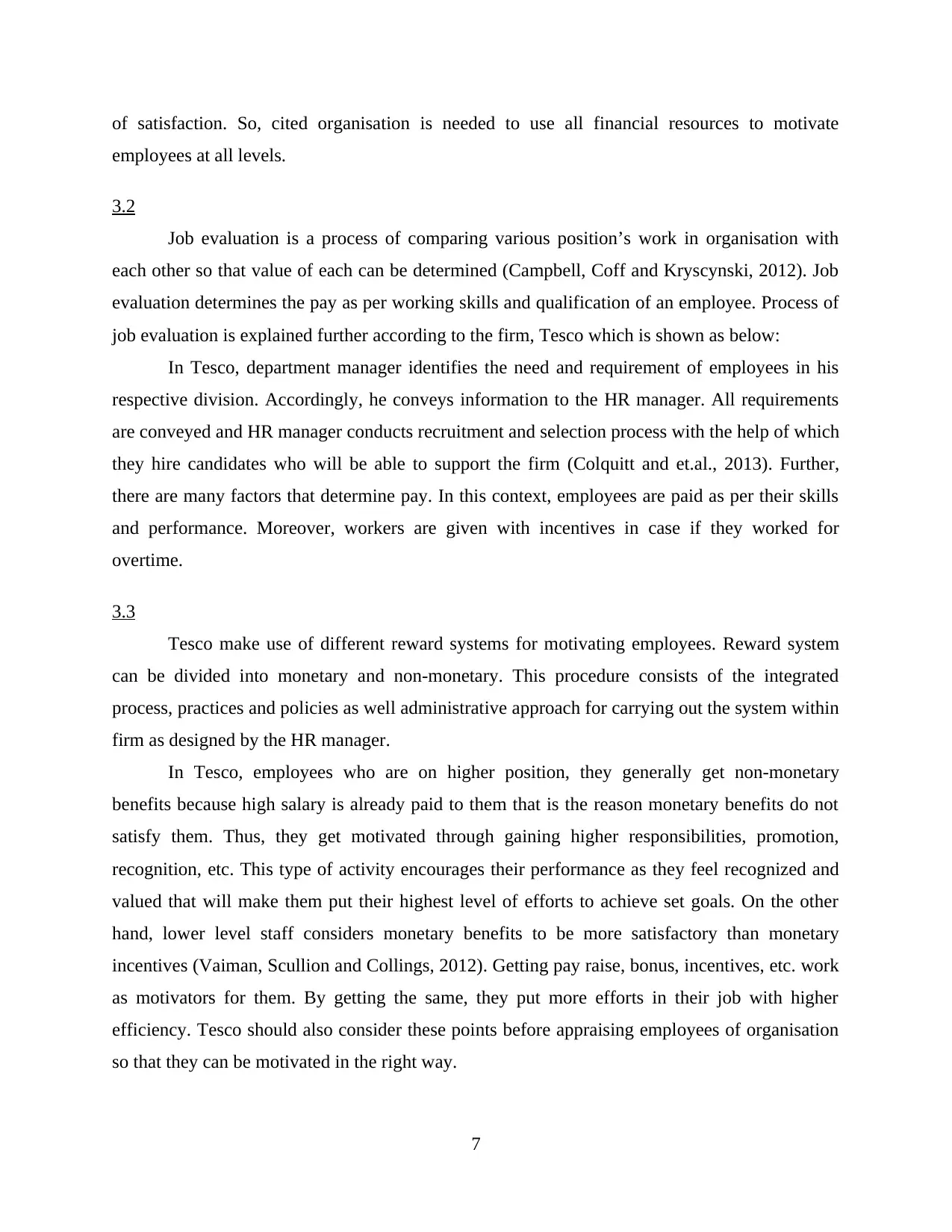
of satisfaction. So, cited organisation is needed to use all financial resources to motivate
employees at all levels.
3.2
Job evaluation is a process of comparing various position’s work in organisation with
each other so that value of each can be determined (Campbell, Coff and Kryscynski, 2012). Job
evaluation determines the pay as per working skills and qualification of an employee. Process of
job evaluation is explained further according to the firm, Tesco which is shown as below:
In Tesco, department manager identifies the need and requirement of employees in his
respective division. Accordingly, he conveys information to the HR manager. All requirements
are conveyed and HR manager conducts recruitment and selection process with the help of which
they hire candidates who will be able to support the firm (Colquitt and et.al., 2013). Further,
there are many factors that determine pay. In this context, employees are paid as per their skills
and performance. Moreover, workers are given with incentives in case if they worked for
overtime.
3.3
Tesco make use of different reward systems for motivating employees. Reward system
can be divided into monetary and non-monetary. This procedure consists of the integrated
process, practices and policies as well administrative approach for carrying out the system within
firm as designed by the HR manager.
In Tesco, employees who are on higher position, they generally get non-monetary
benefits because high salary is already paid to them that is the reason monetary benefits do not
satisfy them. Thus, they get motivated through gaining higher responsibilities, promotion,
recognition, etc. This type of activity encourages their performance as they feel recognized and
valued that will make them put their highest level of efforts to achieve set goals. On the other
hand, lower level staff considers monetary benefits to be more satisfactory than monetary
incentives (Vaiman, Scullion and Collings, 2012). Getting pay raise, bonus, incentives, etc. work
as motivators for them. By getting the same, they put more efforts in their job with higher
efficiency. Tesco should also consider these points before appraising employees of organisation
so that they can be motivated in the right way.
7
employees at all levels.
3.2
Job evaluation is a process of comparing various position’s work in organisation with
each other so that value of each can be determined (Campbell, Coff and Kryscynski, 2012). Job
evaluation determines the pay as per working skills and qualification of an employee. Process of
job evaluation is explained further according to the firm, Tesco which is shown as below:
In Tesco, department manager identifies the need and requirement of employees in his
respective division. Accordingly, he conveys information to the HR manager. All requirements
are conveyed and HR manager conducts recruitment and selection process with the help of which
they hire candidates who will be able to support the firm (Colquitt and et.al., 2013). Further,
there are many factors that determine pay. In this context, employees are paid as per their skills
and performance. Moreover, workers are given with incentives in case if they worked for
overtime.
3.3
Tesco make use of different reward systems for motivating employees. Reward system
can be divided into monetary and non-monetary. This procedure consists of the integrated
process, practices and policies as well administrative approach for carrying out the system within
firm as designed by the HR manager.
In Tesco, employees who are on higher position, they generally get non-monetary
benefits because high salary is already paid to them that is the reason monetary benefits do not
satisfy them. Thus, they get motivated through gaining higher responsibilities, promotion,
recognition, etc. This type of activity encourages their performance as they feel recognized and
valued that will make them put their highest level of efforts to achieve set goals. On the other
hand, lower level staff considers monetary benefits to be more satisfactory than monetary
incentives (Vaiman, Scullion and Collings, 2012). Getting pay raise, bonus, incentives, etc. work
as motivators for them. By getting the same, they put more efforts in their job with higher
efficiency. Tesco should also consider these points before appraising employees of organisation
so that they can be motivated in the right way.
7
⊘ This is a preview!⊘
Do you want full access?
Subscribe today to unlock all pages.

Trusted by 1+ million students worldwide
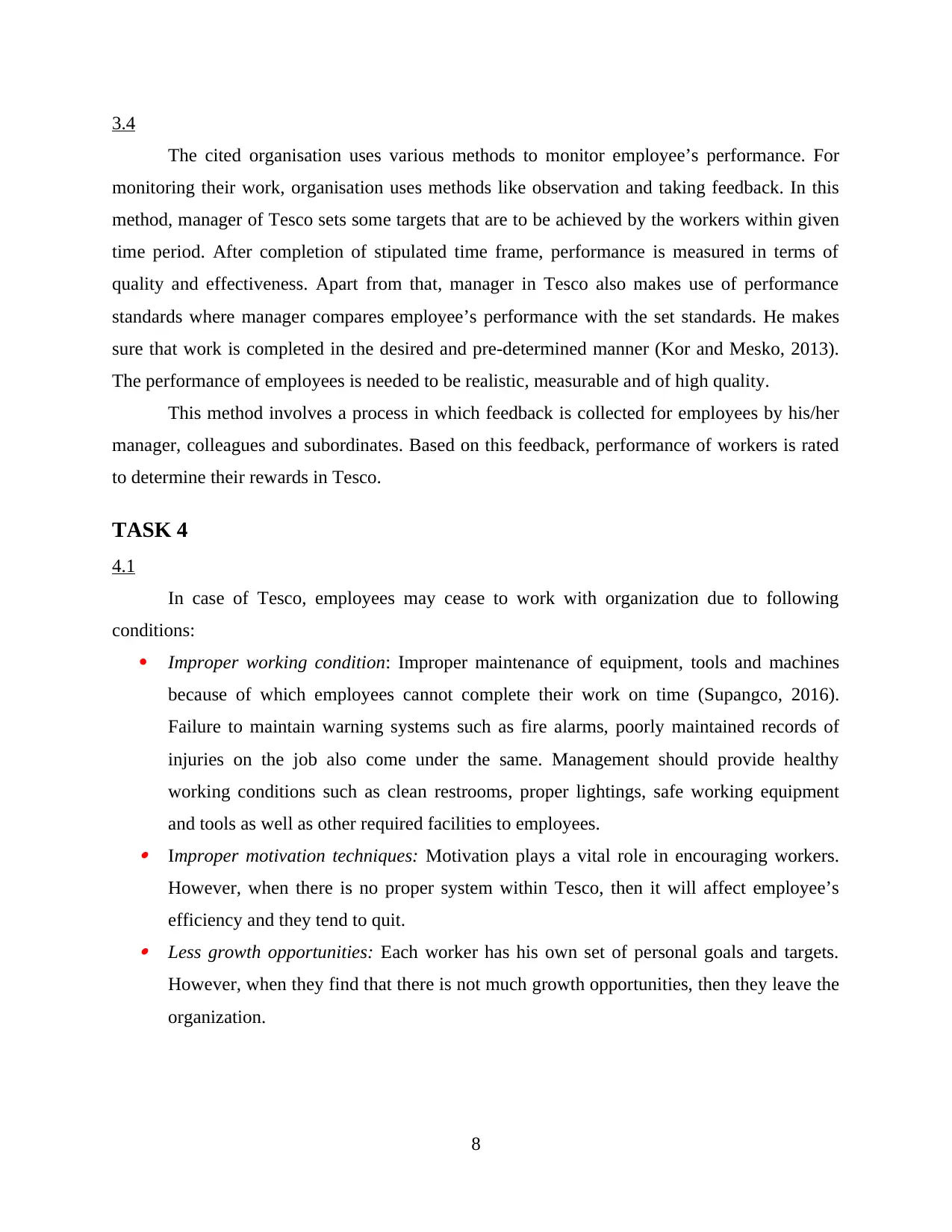
3.4
The cited organisation uses various methods to monitor employee’s performance. For
monitoring their work, organisation uses methods like observation and taking feedback. In this
method, manager of Tesco sets some targets that are to be achieved by the workers within given
time period. After completion of stipulated time frame, performance is measured in terms of
quality and effectiveness. Apart from that, manager in Tesco also makes use of performance
standards where manager compares employee’s performance with the set standards. He makes
sure that work is completed in the desired and pre-determined manner (Kor and Mesko, 2013).
The performance of employees is needed to be realistic, measurable and of high quality.
This method involves a process in which feedback is collected for employees by his/her
manager, colleagues and subordinates. Based on this feedback, performance of workers is rated
to determine their rewards in Tesco.
TASK 4
4.1
In case of Tesco, employees may cease to work with organization due to following
conditions:
Improper working condition: Improper maintenance of equipment, tools and machines
because of which employees cannot complete their work on time (Supangco, 2016).
Failure to maintain warning systems such as fire alarms, poorly maintained records of
injuries on the job also come under the same. Management should provide healthy
working conditions such as clean restrooms, proper lightings, safe working equipment
and tools as well as other required facilities to employees. Improper motivation techniques: Motivation plays a vital role in encouraging workers.
However, when there is no proper system within Tesco, then it will affect employee’s
efficiency and they tend to quit. Less growth opportunities: Each worker has his own set of personal goals and targets.
However, when they find that there is not much growth opportunities, then they leave the
organization.
8
The cited organisation uses various methods to monitor employee’s performance. For
monitoring their work, organisation uses methods like observation and taking feedback. In this
method, manager of Tesco sets some targets that are to be achieved by the workers within given
time period. After completion of stipulated time frame, performance is measured in terms of
quality and effectiveness. Apart from that, manager in Tesco also makes use of performance
standards where manager compares employee’s performance with the set standards. He makes
sure that work is completed in the desired and pre-determined manner (Kor and Mesko, 2013).
The performance of employees is needed to be realistic, measurable and of high quality.
This method involves a process in which feedback is collected for employees by his/her
manager, colleagues and subordinates. Based on this feedback, performance of workers is rated
to determine their rewards in Tesco.
TASK 4
4.1
In case of Tesco, employees may cease to work with organization due to following
conditions:
Improper working condition: Improper maintenance of equipment, tools and machines
because of which employees cannot complete their work on time (Supangco, 2016).
Failure to maintain warning systems such as fire alarms, poorly maintained records of
injuries on the job also come under the same. Management should provide healthy
working conditions such as clean restrooms, proper lightings, safe working equipment
and tools as well as other required facilities to employees. Improper motivation techniques: Motivation plays a vital role in encouraging workers.
However, when there is no proper system within Tesco, then it will affect employee’s
efficiency and they tend to quit. Less growth opportunities: Each worker has his own set of personal goals and targets.
However, when they find that there is not much growth opportunities, then they leave the
organization.
8
Paraphrase This Document
Need a fresh take? Get an instant paraphrase of this document with our AI Paraphraser
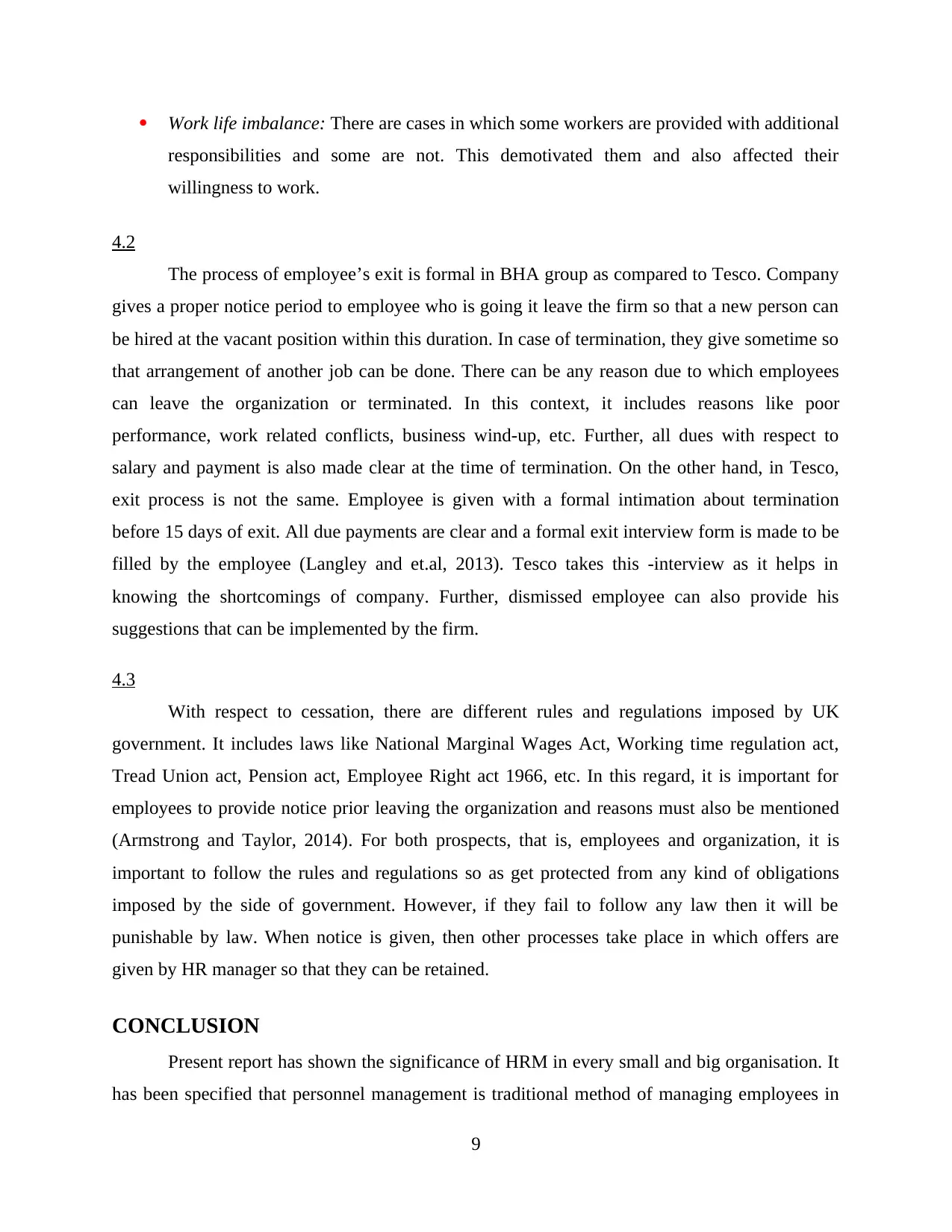
Work life imbalance: There are cases in which some workers are provided with additional
responsibilities and some are not. This demotivated them and also affected their
willingness to work.
4.2
The process of employee’s exit is formal in BHA group as compared to Tesco. Company
gives a proper notice period to employee who is going it leave the firm so that a new person can
be hired at the vacant position within this duration. In case of termination, they give sometime so
that arrangement of another job can be done. There can be any reason due to which employees
can leave the organization or terminated. In this context, it includes reasons like poor
performance, work related conflicts, business wind-up, etc. Further, all dues with respect to
salary and payment is also made clear at the time of termination. On the other hand, in Tesco,
exit process is not the same. Employee is given with a formal intimation about termination
before 15 days of exit. All due payments are clear and a formal exit interview form is made to be
filled by the employee (Langley and et.al, 2013). Tesco takes this -interview as it helps in
knowing the shortcomings of company. Further, dismissed employee can also provide his
suggestions that can be implemented by the firm.
4.3
With respect to cessation, there are different rules and regulations imposed by UK
government. It includes laws like National Marginal Wages Act, Working time regulation act,
Tread Union act, Pension act, Employee Right act 1966, etc. In this regard, it is important for
employees to provide notice prior leaving the organization and reasons must also be mentioned
(Armstrong and Taylor, 2014). For both prospects, that is, employees and organization, it is
important to follow the rules and regulations so as get protected from any kind of obligations
imposed by the side of government. However, if they fail to follow any law then it will be
punishable by law. When notice is given, then other processes take place in which offers are
given by HR manager so that they can be retained.
CONCLUSION
Present report has shown the significance of HRM in every small and big organisation. It
has been specified that personnel management is traditional method of managing employees in
9
responsibilities and some are not. This demotivated them and also affected their
willingness to work.
4.2
The process of employee’s exit is formal in BHA group as compared to Tesco. Company
gives a proper notice period to employee who is going it leave the firm so that a new person can
be hired at the vacant position within this duration. In case of termination, they give sometime so
that arrangement of another job can be done. There can be any reason due to which employees
can leave the organization or terminated. In this context, it includes reasons like poor
performance, work related conflicts, business wind-up, etc. Further, all dues with respect to
salary and payment is also made clear at the time of termination. On the other hand, in Tesco,
exit process is not the same. Employee is given with a formal intimation about termination
before 15 days of exit. All due payments are clear and a formal exit interview form is made to be
filled by the employee (Langley and et.al, 2013). Tesco takes this -interview as it helps in
knowing the shortcomings of company. Further, dismissed employee can also provide his
suggestions that can be implemented by the firm.
4.3
With respect to cessation, there are different rules and regulations imposed by UK
government. It includes laws like National Marginal Wages Act, Working time regulation act,
Tread Union act, Pension act, Employee Right act 1966, etc. In this regard, it is important for
employees to provide notice prior leaving the organization and reasons must also be mentioned
(Armstrong and Taylor, 2014). For both prospects, that is, employees and organization, it is
important to follow the rules and regulations so as get protected from any kind of obligations
imposed by the side of government. However, if they fail to follow any law then it will be
punishable by law. When notice is given, then other processes take place in which offers are
given by HR manager so that they can be retained.
CONCLUSION
Present report has shown the significance of HRM in every small and big organisation. It
has been specified that personnel management is traditional method of managing employees in
9
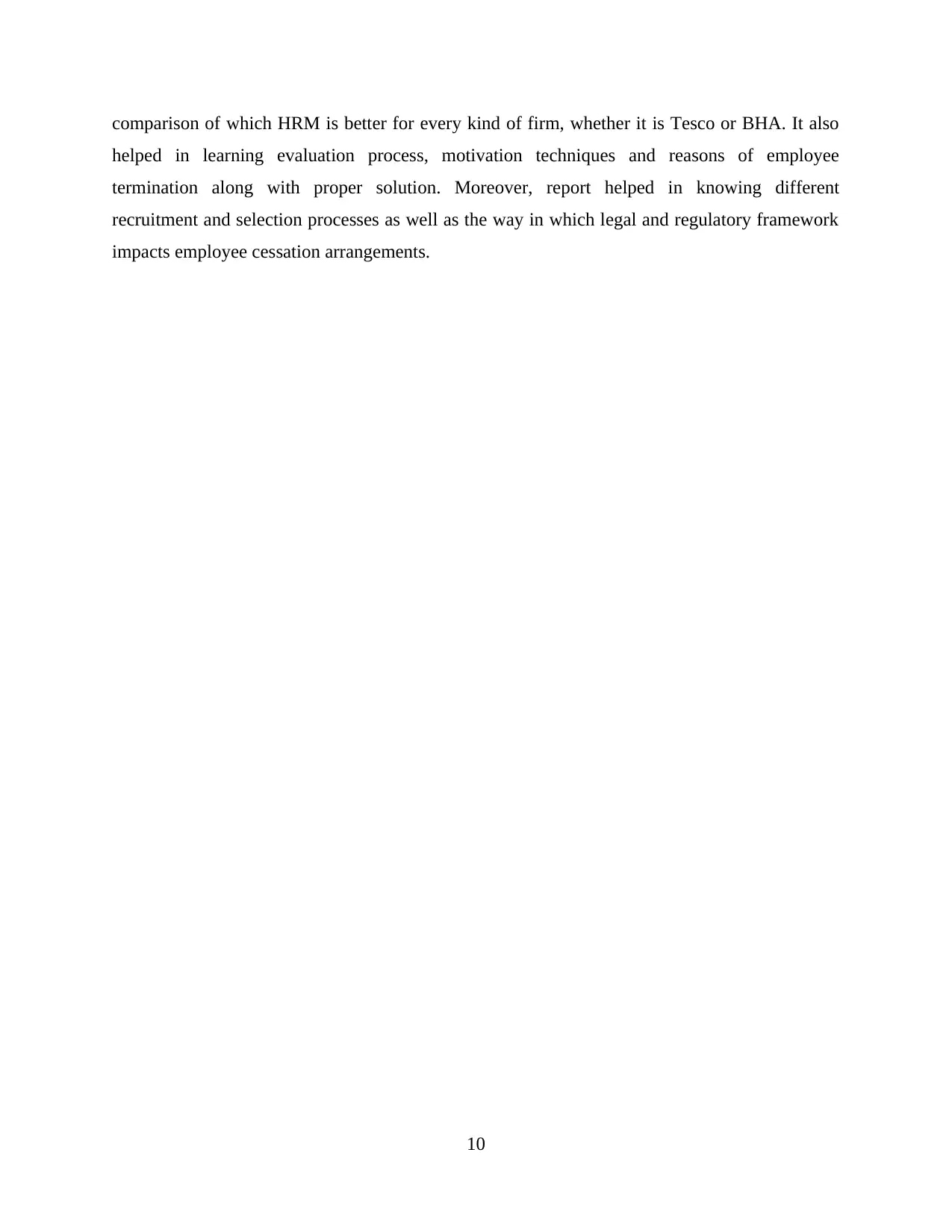
comparison of which HRM is better for every kind of firm, whether it is Tesco or BHA. It also
helped in learning evaluation process, motivation techniques and reasons of employee
termination along with proper solution. Moreover, report helped in knowing different
recruitment and selection processes as well as the way in which legal and regulatory framework
impacts employee cessation arrangements.
10
helped in learning evaluation process, motivation techniques and reasons of employee
termination along with proper solution. Moreover, report helped in knowing different
recruitment and selection processes as well as the way in which legal and regulatory framework
impacts employee cessation arrangements.
10
⊘ This is a preview!⊘
Do you want full access?
Subscribe today to unlock all pages.

Trusted by 1+ million students worldwide
1 out of 14
Related Documents
Your All-in-One AI-Powered Toolkit for Academic Success.
+13062052269
info@desklib.com
Available 24*7 on WhatsApp / Email
![[object Object]](/_next/static/media/star-bottom.7253800d.svg)
Unlock your academic potential
Copyright © 2020–2025 A2Z Services. All Rights Reserved. Developed and managed by ZUCOL.





